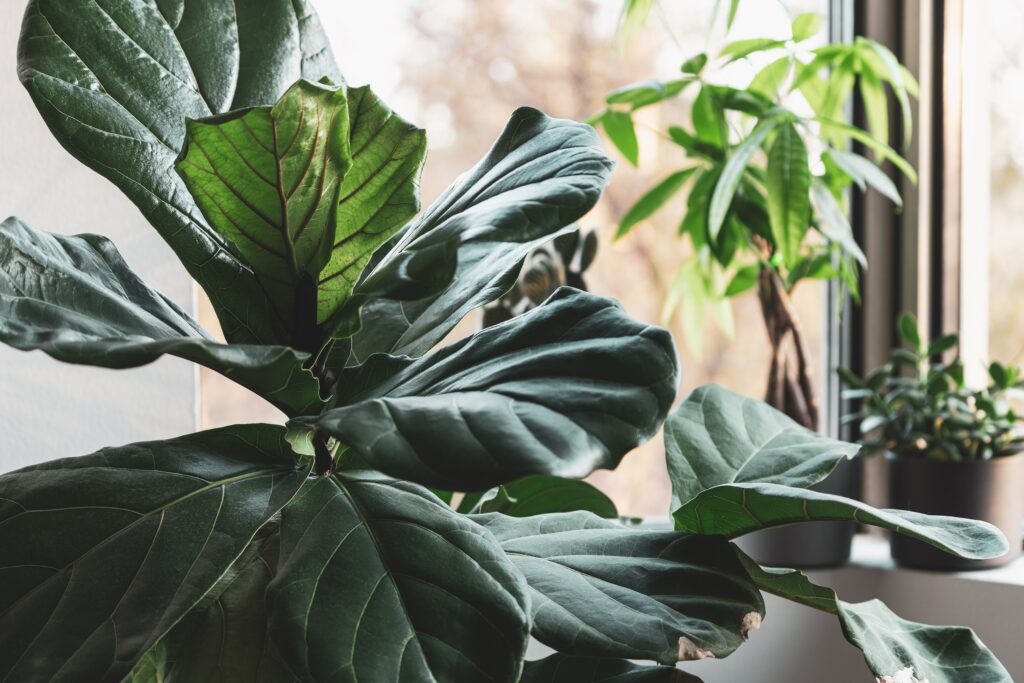Popular among interior designers and houseplant enthusiasts for over a decade, the Ficus lyrata – better known as the Fiddle Leaf Fig – can be found today in most big box stores, local nurseries, or even grocery stores. You may notice that this popularity comes with a slightly higher cost. In this guide, we’ll see just why are Fiddle Leaf Figs so expensive, and if their beauty and popularity are worth the extra cost.
It’s no surprise why these beautiful trees have a cult-like following, or why they command a higher price tag than other entry-level tropical houseplants… Fiddle Leaf Figs are beautiful plants, easy to grow, and are now widely available. Read on to see why these plants may be hold more value beyond the price tag at your nursery.
Contents
- Fiddle Leaf Figs have surged in popularity
- Fiddle Leaf Figs can thrive in most homes
- Fiddle Leaf Figs are actually easy to care for
- Fiddle Leaf Figs can get big and beautiful
- Fiddle Leaf Figs bring the outdoors in
- Fiddle Leaf Figs are great for small spaces
- Fiddle Leaf Figs love growing outdoors
- Fiddle Leaf Figs grow fast
- Fiddle Leaf Figs are easy to find at nurseries
- Fiddle Leaf Figs need time to adapt to your home
- Fiddle Leaf Figs are a fit for any budget
- Fiddle Leaf Figs are easy to shape and size
- Fiddle Leaf Figs are easy to propagate
- Are Fiddle Leaf Figs worth buying?
Fiddle Leaf Figs have surged in popularity
It’s hard to visit any nursery center, plant website or social media without encountering the always photogenic Fiddle Leaf Fig. The plant has been a staple among growers for many years. And as designer photography has played a bigger role in real estate listings, it’s common to find homes sporting a beautiful Ficus lyrata in their interior photos.
The Fiddle Leaf Fig is so popular among designers, houseplant enthusiasts, and even impulse buyers who see them on shopping trips. These big and beautiful plants are a dramatic addition to any home thanks to their big, beautiful foliage.
Fiddle Leaf Figs can thrive in most homes
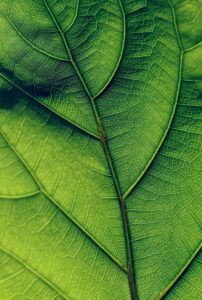 Fiddle Leaf Figs get a bad reputation for being hard to care for. But these trees will do well with interior conditions found in most homes. As long as they have sufficient light, regular water and other basic care, these plants will thrive.
Fiddle Leaf Figs get a bad reputation for being hard to care for. But these trees will do well with interior conditions found in most homes. As long as they have sufficient light, regular water and other basic care, these plants will thrive.
When these plants aren’t happy, they may develop discolored leaves, or drop them completely to let you know something is wrong. But plants doing this typically have one or more issues as a result of poor conditions.
Fiddle Leaf Figs are very adaptable plants, but can’t be completely ignored. With some attention to their care needs, these trees will thrive in your home.
Fiddle Leaf Figs are actually easy to care for
The care needs of Fiddle Leaf Figs aren’t difficult for growers who can keep a regular plant care schedule and have a spot in mind that gets enough lighting. It’s simple to keep Fiddle Leaf Figs very happy:
☀️Lighting – Fiddle Leaf Figs love a medium to high amount of bright indoor light. A sunny window that provides 6-8 hours of daylight is perfect for their needs.
💧Water – Overwatering is the #1 issue with Ficus lyrata. Let your tree dry out completely between waterings, and ensure your pot has drainage so the roots don’t sit submerged.
💨Humidity – Fiddle Leaf Figs love higher humidity but will tolerate lower humidity during the winter dormant months. Misting won’t really help, but a humidifier can go a long way to keep your plant happy.
🧽Cleaning – Wiping the leaves with a damp cloth weekly will remove dust and ensure your plant can absorb moisture and process light to keep it healthy. You’ll be surprised to see how much dirt accumulates on these big and beautiful leaves!
💚Fertilizer – Adding a liquid fertilizer during the spring and summer growing season will encourage new growth and make sure your tree is getting the nutrients it needs to stay healthy.
🌡️Temperature – Fiddle Leaf Figs will do well with interior temperatures of most homes, and will also love summer heat, provided the humidity levels are moderate to high. They don’t do well with cold drafts, so avoid keeping them near drafts during the chilly winter months.
Jump to our full Fiddle Leaf Fig care guide now for a deeper dive into Ficus lyrata care >
Fiddle Leaf Figs can get big and beautiful
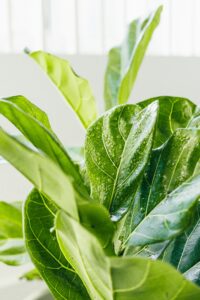 If you’ve ever asked why Fiddle Leaf Figs are so expensive, you may have only looked at a large, mature tree. Smaller Fiddles can be found in 4” or 6” pots will be happy on windowsills today, and grow into large tress over time. The best part is that the prices for smaller Fiddle Leaf Figs have also dramatically decreased in price, to the point where they can be found at grocery stores or a variety of other retailers that don’t specialize in plants.
If you’ve ever asked why Fiddle Leaf Figs are so expensive, you may have only looked at a large, mature tree. Smaller Fiddles can be found in 4” or 6” pots will be happy on windowsills today, and grow into large tress over time. The best part is that the prices for smaller Fiddle Leaf Figs have also dramatically decreased in price, to the point where they can be found at grocery stores or a variety of other retailers that don’t specialize in plants.
While you won’t have the instant “wow” factor, purchasing a small Fiddle Leaf Fig and growing it over time will help it acclimate to your home and give you complete control over it’s care, helping make the plant be much more personalized to your space, and much more rewarding when it does reach its mature size.
Fiddle Leaf Figs bring the outdoors in
The large, dark green leaves of the Fiddle Leaf Fig are a great reminder of the outdoors. This is especially true for apartments offices that may not have easy access to private outdoor space.
With the Fiddle Leaf Fig, houseplant lovers can create a small natural oasis inside, whether it’s part of a larger houseplant collection or kept as a single statement plant.
Fiddle Leaf Figs are great for small spaces
It might sound counterintuitive that the massive, fiddle-shaped leaves of Ficus lyrata are perfect for studio apartments, offices, or other spaces that have limited floorspace. But the plant’s thin trunks and desire to be kept in smaller pots compared to its vertical growth mean Fiddle Leaf Figs can occupy a very small footprint, saving precious space.
Many Fiddle Leaf Figs will be incredibly happy in 12” to 18” pots, easily growing 6 – 10 feet in height. This pot-to-plant ratio allows them to easily become a green staple of any room without the need for a massive container unlike other trees.
For many people with cozy living rooms or otherwise limited space for plants, the Fiddle Leaf Fig is the go-to plant to bring a piece of the outdoors inside.
Fiddle Leaf Figs love growing outdoors
Speaking of the outdoors, Fiddle Leaf Figs can thrive in backyards or small patios during the warm summer months. Just ensure their sensitive leaves do not receive any direct sunlight exposure that will burn after even a few minutes of exposure.
A shady spot outdoors will encourage growth more than plants kept indoors year-round. If your outdoor climate also has high humidity, this will also help the Fiddle Leaf Fig create new leaves and branches even faster.
Once temperatures begin to drop into the low 60ºs, it’s time to bring them back inside for the cooler months. Your plant likely will enter a dormant period and limit or completely stop growth, but this is completely normal as your Fiddle prepares for the winter season.
Fiddle Leaf Figs grow fast
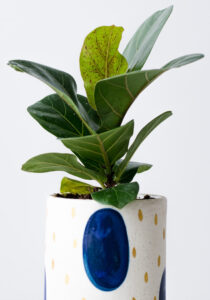 Those who have asked why are Fiddle Leaf Figs so expensive after looking at the price for these large, mature plants may not realize that it’s a lot more affordable to start with a small or medium Ficus lyrata.
Those who have asked why are Fiddle Leaf Figs so expensive after looking at the price for these large, mature plants may not realize that it’s a lot more affordable to start with a small or medium Ficus lyrata.
With the right care, these plants are incredibly fast growers. It’s common for Fiddle Leaf Figs to grow 1 – 2 feet during the summer growing season, sending out newer and larger leaves at their crown.
Growers with more mature plants that are a few years old may also choose to pinch the top node during the early spring growing season, which will encourage new branching and leaf growth as well.
It’s not a surprise that large, mature plants, which have been cultivated in greenhouses for years can cost hundreds of dollars. But smaller plants are readily available at virtually any price point, making Fiddle Leaf Fig plants more affordable than some shoppers may realize.
Fiddle Leaf Figs are easy to find at nurseries
Not only do Fiddle Leaf Figs come in a variety of sizes, their explosion in popularity has also meant that they can be found virtually anywhere. Once only available at specialty plant stores and nurseries, Ficus lyrata can now be easily found at big box stores and even grocery store floral departments for reasonable prices.
This access is amazing because it opens up availability for houseplant enthusiasts who may not have a nearby specialty nursery, or the budget for a large and mature plant. But with any plant purchase, buyers should be careful to inspect any plants at the store before selecting a plant for purchase.
Plants like the Fiddle Leaf Fig grown and shipped to stores at a massive scale can be prone to pests or root rot if not kept in ideal conditions. It’s best to inspect plants carefully to look for any pets on the leaves (including the undersides), discoloration, or other signs of decline like dark, crunchy leaves that could be a sign of leaf burn or poor watering. Finding any issues before purchasing will ensure you bring home a healthy plant. Many wondering just why are Fiddle Leaf Figs so expensive may have skipped these steps and ended up with a plant in decline.
🌱Note: Nursery plants may have speckled red discoloration on new leaves. This is very common in younger plants. The condition is a result of new cells expanding too quickly as the leaf grows. As the leaf matures and thickens, the pattern will disappear leaving the dark green color that Ficus lyrata is known for.
Fiddle Leaf Figs need time to adapt to your home
A quick inspection at the store will ensure you are leaving with a healthy plant that will thrive. One you get home with your plant, it may take a few weeks to adjust to the different humidity, lighting, and temperatures it was accustomed to in both the store as well as its original greenhouse.
Following the key care tips mentioned in this guide will help, but it won’t be out of the ordinary if your plant drops lower leaves or has stunted growth as it understands its new home. If your plant continues to drop leaves, make sure it’s not near any drafty doors or windows, as this can cause the plant stress. Giving your Ficus lyrata attention and care during this transition will go a long way to helping it acclimate to your home and keeping your new plant healthy.
Fiddle Leaf Figs are a fit for any budget
With their mass appeal, universal availability, and variety of size options, Fiddle Leaf Figs are finally at the point of being able to match virtually any budget. Years ago, when Fiddle Leaf Figs were just gaining popularity, many asked the question, “why are Fiddle Leaf Figs so expensive?”
The fact is, this is no longer the case. These stunning plants are available in so many different sizes and styles – from single-stem trees to bushy arrangements. They also range from new plants that are just a few weeks old to mature trees that can reach the ceiling.
Across these styles and sizes are a full spectrum of prices to match virtually any budget, finally making this plant available to anyone with an interest in raising this gorgeous plant.
Fiddle Leaf Figs are easy to shape and size
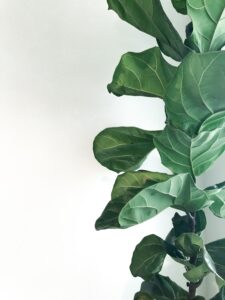 Whether you want a lanky, single-stem plant or more bushy foliage, Fiddle Leaf Figs can be easily controlled to grow to your desire. By pinching the top crown, you can encourage bushy growth, or making a cut will encourage branching to occur, giving your plant more of a miniature tree appearance.
Whether you want a lanky, single-stem plant or more bushy foliage, Fiddle Leaf Figs can be easily controlled to grow to your desire. By pinching the top crown, you can encourage bushy growth, or making a cut will encourage branching to occur, giving your plant more of a miniature tree appearance.
Multiple Fiddle Leaf Fig stems can even be grown in the same container, giving the appearance of a lush landscape. Whether you’re looking to have a pencil-thin stalk or branch out, it’s easy to completely control the look of the Fiddle Leaf Fig.
Fiddle Leaf Figs are easy to propagate
Beyond shaping your Ficus lyrata, it’s also easy to propagate Fiddle Leaf Figs to make new plants. Stem cuttings can be easily propagated in water to eventually root after a few weeks. Once the roots are a few inches in length, they can be transferred to soil – to grow alongside the parent plant, in an all-new container, or gifted to a friend.
Easy propagation can help a Fiddle Leaf Fig collection grow over time. The simple nature to grow multiple plants also makes Fiddle Leaf Figs very cost-effective if you can create multiple children plants from the original.
Are Fiddle Leaf Figs worth buying?
Whether you want to take the plunge and purchase a Fiddle Leaf Fig is a personal decision. Before deciding to take one of these plants home, make sure your home can support their care needs of the right temperature, lighting, humidity and watering schedule.
The Ficus lyrata is a great plant to learn how to tailor a care schedule to a plant that’s more advanced than an entry-level pick. But if you’re completely new to plants, it might be a good idea to browse our list of hard to kill plants to get started.
🌱Related Guide: The best hard to kill plants for new plant parents >
While some people still ask why are Fiddle Leaf Figs so expensive, we hope this guide helped show the value these plants can bring – especially since they are now widely available at virtually all price points.
And if you’re a little nervous about the care requirements of the Fiddle Leaf Fig, but enjoy the look of this beautiful plant, you may be interested in the Ficus Audrey. This Fiddle Leaf cousin is much more forgiving, just as beautiful, and we have a complete care guide to get you started.
Whichever plant you decide to bring home, we hope you have a better understanding of the care needs and unique personality of the Fiddle Leaf Fig after reading our guide.

